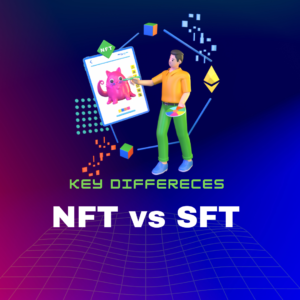Define and what’s mean by NFT and SFT
NFTs
In this Article we discuss about NFT vs SFT key difference in 2024 before that we want to understand these terms. First, NFTs its mean by Non-Fungible Tokens (NFTs). They are type of digital asset that represents ownership or proof of authenticity of a unique item or piece of content using blockchain technology such as Digital art, collectibles, virtual real estate, gaming items, and more. Ownership is recorded on the blockchain, providing proof of authenticity and ownership.
NFTs are unique in comparison to cryptocurrencies like Bitcoin and Ethereum, which are fungible and may be traded for one another. Because of their individuality, they are especially valued in the fields of collectibles, gaming, music, and art. As an example, the original artwork is represented by the particular token that is created when an artist makes a digital painting and creates it as an NFT. It is similar to owning an original painting compared to a print: even if someone captures a screenshot of the painting, they do not own the NFT.
SFTs
Semi-Fungible Tokens (SFTs) type of digital asset that combines features of both fungible and non-fungible tokens, allowing for a balance between uniqueness and interchangeability. They may stand for both distinct and transferable resources. At first, SFTs may be exchanged like cryptocurrencies as they are fungible tokens. After a certain condition is met, they can become non-fungible, representing unique ownership or identity, such as a ticket after it has been used or a game item that has been personalized.
Consider a game in which players receive tokens for winning challenges. These tokens can first be exchanged between players. Tokens, however, become non-fungible if a player uses them to buy a special in-game item, indicating ownership of that particular item.
NFT vs SFT key difference in 2024
These differences highlight the distinct roles and applications of NFTs and SFTs in the digital asset ecosystem.
-
Fungibility
NFT : Each token is unique and cannot be exchanged for another token of the same kind. This uniqueness is what gives NFTs their value.
SFT : Initially fungible, SFTs can be traded like cryptocurrencies. However, they can also become non-fungible when they are used in specific situations.
-
Ownership and Transferability
NFT : On the blockchain, ownership is transparent and traceable, making authenticity verification simple. The ownership of the NFT passes to the new owner upon sale.
SFT : Although they are exchangeable like fungible tokens, who owns them depends on how they are used. An SFT might no longer be interchangeable once it has been utilized in a particular context.
-
Use Cases
NFT : Mostly utilized for virtual real estate, music, art, and collectibles on the internet. They are perfect for products where authenticity and originality are essential.
SFT : Suitable for applications that require both fungibility and uniqueness, such as gaming, loyalty programs, and event ticketing.
-
Economic Model
NFT : Usually involves unique types of ownership and frameworks based on limited availability.
SFT : Enables economic models to leverage bulk trading and unique ownership, providing advantages from both fungibility and non-fungibility.
-
Market Value
NFT : The NFT market is known to be unpredictable, as prices are heavily influenced by the popularity of one-of-a-kind items. The worth of NFTs can vary greatly depending on current fads and the level of interest from collectors.
SFT : Market conditions may become more predictable, particularly when applied in gaming or rewards systems, due to their flexibility which enables wider exchange possibilities.
-
Divisibility
NFT : Because NFTs are naturally indivisible, it means that they are whole things that cannot be divided into smaller components. For example, you cannot split a digital art NFT into parts and sell them separately; the entire token represents the ownership of the whole artwork
SFT : SFTs can be split into smaller pieces that can be traded or swapped independently while they are in their fungible state. For instance, an SFT representing in-game currency can be divided into smaller amounts for transactions.
Once an SFT transitions to a non-fungible state, it becomes indivisible like an NFT.
-
Smart Contract Integration
NFT : Focus on unique, indivisible assets. Smart contracts manage unique ownership, attributes, and transfers.
SFT : Combine fungible and non-fungible properties. Smart contracts handle bulk transactions and transitions to unique states, offering greater flexibility.
-
Flexibility
NFT : Provide great adaptability for individual, exclusive assets but are not versatile for mass production or swap-out situations.
SFT : Provide superior flexibility by combining fungible and non-fungible characteristics, allowing for efficient management of both bulk and unique assets
Conclusion
While NFTs and SFTs are both modern digital assets that make use of blockchain technology, they serve distinct purposes and have distinguishing characteristics. While SFTs combine interchangeability with uniqueness to provide flexibility for many purposes, NFTs emphasize possession and individuality. It will be necessary for those who want to use these technologies to understand these differences as the digital landscape develops.
